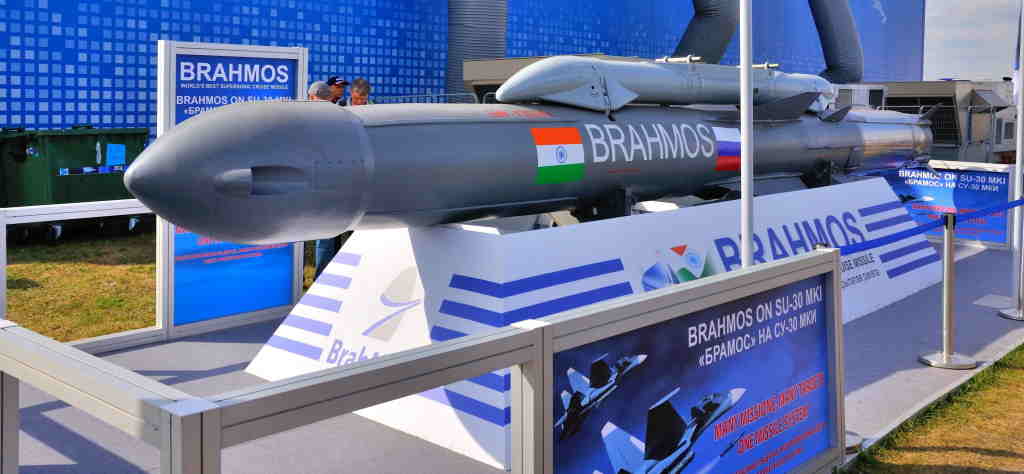

Brahmos Missile
<p>
India has moved a number of indigenous missiles to its northern and eastern borders after China intruded into Indian territory at a number of points and deployed exceptionally large numbers of soldiers and weapons on the border. India too began rushing men and materials around mid-May after the Chinese intrusion was detected during the coronavirus days.</p>
<p>
To take on an increasingly aggressive China, India has rushed in additional troops, infantry combat vehicles, howitzers, tanks, missiles and radars. Among this large posse of weapons, a number of indigenously developed missiles have been placed on the border.</p>
<p>
Of all the missiles, the most formidable is the BrahMos&mdash;one that China fears. According to news reports, India had deployed the BrahMos supersonic cruise missiles on the Chinese border a few years back and China had made a big hue and cry about it. In the current circumstances, the BrahMos will be an asset for India as the Chinese fear it because of its precision strikes and its steep-dive attack capabilities which allow it to hit targets hidden in mountainous areas.</p>
<p>
Developed as a joint venture with Russia, the BrahMos have been developed for four platforms&mdash;ship-based, land-based, air-launched and submarine-based weapons systems. The Defence Research and Development Organisation (DRDO) is developing another version which will be an air-to-air. Owing to its versatility, all three arms of the Indian military have inducted the BrahMos.</p>
<p>
With the Chinese not showing signs of retreating, by June, India had deployed Akash&mdash;the quick-reaction air defence missile which can bring down helicopters, fast-moving combat aircraft, missiles and unmanned aerial vehicles. It has been upgraded to make it suitable for deployment in the cold mountainous terrain along the Chinese border.</p>
<p>
Akash is known as India&#39;s first indigenously developed medium-range surface to air missile. It is all-weather and can detect, track and destroy targets at low, medium and high altitudes up to 30 km. It can trail and target numerous targets simultaneously. Another missile system that has been placed on the borders with China and Pakistan in the past few months is the Pinaka&mdash;named after Lord Shiva&#39;s bow.</p>
<p>
The Pinaka Rocket System is a long-range artillery system to launch an attack on the enemy before close-quarter combat. These are made by the public sector unit Bharat Earth Movers and in the private sector by Tata Power Company and Larsen &amp; Toubro. Pinaka is a multi-barrel rocket system and was used during the Kargil War in 1999 when Pakistani troops had entered Indian territory and occupied peaks with an intent to cut off Kashmir from the rest of India.</p>
<p>
Pinaka Mark-I has a range of 40 km while the Mark-II has a range of 75 km. Troops on the China border have also been provided with shoulder-fired missiles to take down low-flying helicopters and aircraft which have a range of 2-5 km.</p>
<p>
With tens of thousands of heavily-armed soldiers and modern weapons, tensions are high between the neighbors. However, New Delhi has made efforts to de-escalate the situation and involve Beijing in talks at various levels. The Defence Ministers and the Foreign Affairs Ministers of the two countries met in Moscow in September.</p>
<p>
Despite many rounds of diplomatic and military talks, the Chinese have not moved back from the Indian territory they occupied during the Covid crisis when the Indian troops were at peacetime locations. Instead, with China putting in additional men and machines, India too had to rush more weapons and soldiers. Besides the India-made missiles, the other air defence weapons placed on the border include ones procured from Israel, Europe, Russia and the US. These air defence systems detect and take down enemy weaponry such as fighter jets, helicopters, missiles and military drones.</p>
<p>
Recently, India celebrated a milestone in its missile technologies when the DRDO successfully tested the Hypersonic Technology Demonstration Vehicle (HSTDV) off the coast of Odisha. This ultra-modern technology had been tested last year also, but it did not clear all parameters at that time. This time, a ship was deployed in the Bay of Bengal to monitor the performance of the launch and cruise vehicle as well as the scramjet engine.</p>
<p>
India has a large array of missiles including the Agni series from I to VI. It also has the Prithvi, Prahaar and Nirbhay missiles. With missiles across all ranges and platforms, India&#39;s three-decade old Integrated Guided Missile Development Programme (IGMDP) has made the country largely self-sustainable in missile technologies. The IGMDP, which was the brainwave of missile man and the late president A.P.J. Abdul Kalam, had people from DRDO and the three forces. The IGMDP took its initial steps with five missiles:</p>
<p>
Prithvi, short-range surface-to-surface missile; Agni, intermediate-range surface-to-surface missile; Trishul, short-range surface-to-air missile; Akash, medium-range surface-to-air missile; and Nag, anti-tank missiles. India&#39;s missile research and development programme, which stands along with the top countries in the world will get a further flip with Prime Minister Narendra Modi&#39;s focus on indigenous technologies in defence and weapons. For the first time, India has begun to export locally manufactured weapons and defence technologies as well.</p>
Taiwan's military is prioritising combat readiness as a key aspect of deterrence due to escalating…
Calling for an increase in the speed of development, Prime Minister Narendra Modi said on…
The Scottish Government has reaffirmed its commitment to supporting religious freedom and human rights for…
Tara Chand Baloch, the President of the Baloch American Congress and a former Cabinet minister…
In a groundbreaking study, researchers from McGill University have identified nine biological markers in the…
India, in a firm and unequivocal statement at the United Nations Security Council (UNSC), accused…